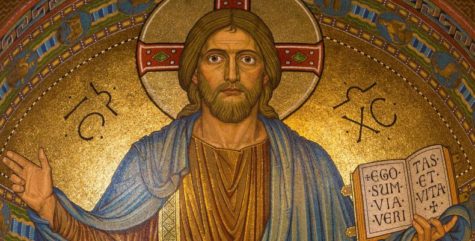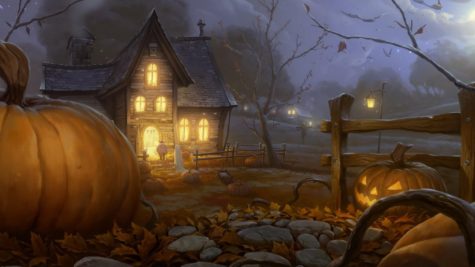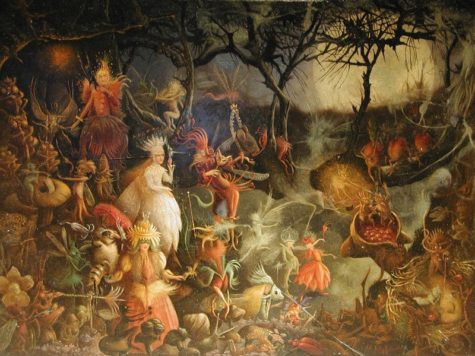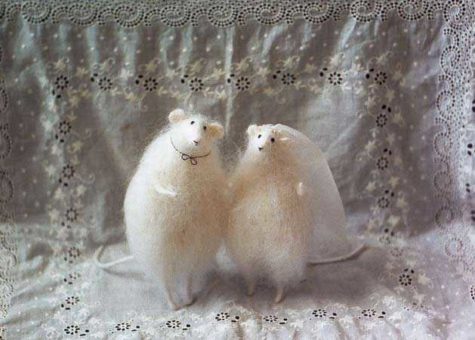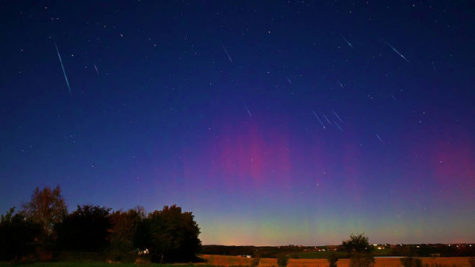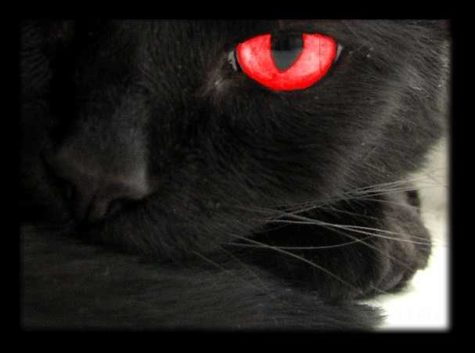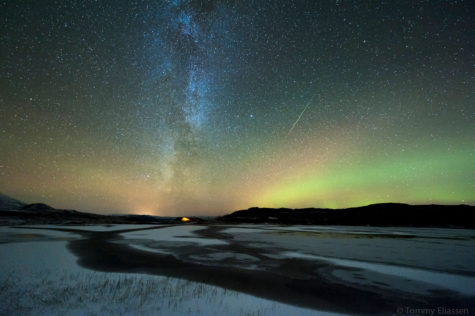October
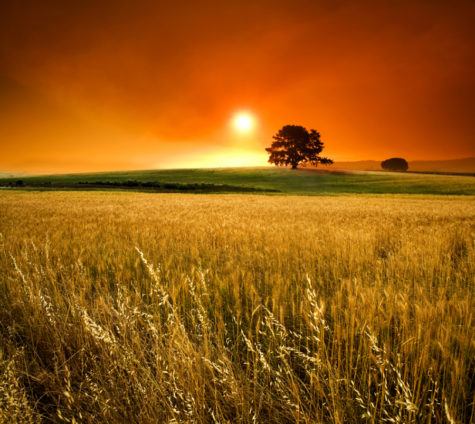
In many cultures around the world, staple crops such as corn and rice are believed to embody a spiritual essence.
In European cultures, a corn doll was often used to represent the spirit of the harvested crops. However, Europe didn’t have a monopoly on this at all. In South American countries, some tribes took the largest portion of the crops — typically maize — and dressed it in clothing as an effigy.
In Peru, people honored different spirits of the crops. The Maize Mother was the zara mama, the spirit of quinoa was known as quinoa mama, and everything from the cocoa tree to the lowly potato had a life essence.
In North America, the native tribes grew corn, or maize, as a staple part of their diet. Some groups have stories of rebirth and regeneration, and a few have folktales that parallel the story of Demeter and Persephone. In the southwestern part of the United States, Native Americans still perform a ceremonial dance that honors the harvesting of the maize every fall.
It’s not uncommon to find spiritual connections to agriculture. The Malay people of Indonesia believe that rice plants — again, a staple crop — possess a soul or life force just as humans do. Harvesting is even done in a way that is seen as “painless” to the rice plants, so that it will not suffer. In some parts of the Malay Peninsula, there is a big ceremony at the beginning of each harvest, in which a complex ritual is performed that identifies the mother of the rice soul in the selected sheaf.
Folklorist Sir James Frazer makes mention in The Golden Bough of the global phenomenon of the honoring of the spirit of the grain. He says that the mere fact that underdeveloped, primitive cultures honor a “corn mother” archetype indicates that this has been going on for thousands of years. In other words, because these cultures are “unspoiled” by modern society, their worship of such an embodiment of the grain is probably very close to the original ritual and ceremony.
Article by: Patti Wigington
We do not bring God into time; He is the Creator of time. In the mystery of the Incarnation, the Eternal Word through whom the universe was created entered into time to re-create it from within!
The Solemnity of Our Lord Jesus Christ, King of the Universe, commonly referred to as the Feast of Christ the King, is a relatively recent addition to the Western liturgical calendar, having been instituted in 1925 by Pope Pius XI for the Roman Catholic Church. In 1970 its Roman Catholic observance was moved to the final Sunday of Ordinary Time. Therefore, the earliest date on which it can occur is 20 November and the latest is 26 November. Traditional Catholics observe it on its original date, the last Sunday of October.
- The liturgical vestments for the day are colored white or gold, in keeping with other joyous feasts honoring Christ.
In the Evangelical-Lutheran Church of Sweden, this day is referred to as the Sunday of Doom, previously highlighting the final judgement, though after 1983 the theme of the day was amended to the Return of Christ. In the Church in Wales, the 4 Sundays before Advent are called the “Sundays of the Kingdom” and Christ the King is observed as a season and not a single festal day.
- Some Anglicans refer to this Sunday as “Stir-up Sunday.”
First, the Anglican collect for the day begins with the words, “Stir up, we beseech thee, O Lord, the wills of thy faithful people…” Second, some old pudding recipes require the pudding to sit for several weeks before being cooked. This Sunday became a day that people would traditionally begin preparing pudding for Christians, which includes “stirring it up.”
These two things came together in people’s minds, as Wikipedia explains: “Supposedly, cooks, wives and their servants would go to church, hear the words ‘Stir up, we beseech thee, O Lord…’, and be reminded, by association of ideas, that it was about time to start stirring up the puddings for Christmas.”
Celebrations include the following:
- Many Christian churches have masses that celebrate Christ.
- Some people take the time out of their day to reread Pope Pius XI’s encyclical Quas primas
- Participation in many of the Christ the King processions that occur on this day
- Some people recite the Act of Dedication of the Human Race to Jesus Christ King.
Many people celebrate Jesus Christ with a celebration that can feature food items such as crown cupcakes (a representation of Christ as king); cakes topped with icing thorns or King Cakes baked in the shape of a crown.
Act of Dedication of the Human Race to Jesus Christ King
Most sweet Jesus,
Redeemer of the human race,
look down upon us humbly prostrate before You.
We are Yours, and Yours we wish to be;
but to be more surely united with You,
behold each one of us freely consecrates himself today
to Your Most Sacred Heart.
Many indeed have never known You;
many, too, despising Your precepts, have rejected You.
Have mercy on them all, most merciful Jesus,
and draw them to your Sacred Heart.
Be King, O Lord,
not only of the faithful who have never forsaken You,
but also of the prodigal children who have abandoned You;
grant that they may quickly return to their Father’s
house,
lest they die of wretchedness and hunger.
Be King of those who are deceived by erroneous opinions,
or whom discord keeps aloof,
and call them back to the harbor of truth
and the unity of faith,
so that soon there may be but one flock and one Shepherd.
Grant, O Lord, to Your Church assurance of freedom
and immunity from harm;
give tranquility of order to all nations;
make the earth resound from pole to pole with one cry:
Praise to the Divine Heart that wrought our salvation;
to it be glory and honoUr for ever.
Amen.
From: Wikipedia and other sources
The Taurids is a long-running minor meteor shower producing only about 5-10 meteors per hour. It is unusual in that it consists of two separate streams. The first is produced by dust grains left behind by Asteroid 2004 TG10. The second stream is produced by debris left behind by Comet 2P Encke. The shower runs annually from September 7 to December 10. Best viewing will be just after midnight from a dark location far away from city lights. Meteors will radiate from the constellation Taurus, but can appear anywhere in the sky.
Source: SeaSky
Halloween or All Hallow’s Eve occurs on October 31, and originated with the ancient Celts, who, beginning at sundown on October 31 and extending into November 1, celebrated Samhain (pronounced sow-in, which rhymes with cow-in), which marked the end of harvest time and the beginning of the new year. The ancient Celts believed that at this time, the veil between the worlds of the living and the dead was at its thinnest, thereby making it a good time to communicate with the deceased and to divine the future.
In later years, the Irish used hollowed-out, candlelit turnips, carved with a demon’s face to frighten away the spirits. When Irish immigrants in the 1840s found few turnips in the United States, they used the more plentiful pumpkins instead.
Halloween activities include:
- Trick-or-treating (going door to door in costume and asking for treats)
- Attending Halloween costume parties
- Decorating, carving pumpkins into jack-o’-lanterns
- Lighting bonfires
- Apple bobbing
- Divination games
- Playing pranks
- Visiting haunted attractions
- Telling scary stories and watching horror films.
In many parts of the world, the Christian religious observances of All Hallows’ Eve, including attending church services and lighting candles on the graves of the dead, remain popular, although elsewhere it is a more commercial and secular celebration. Some Christians historically abstained from meat on All Hallows’ Eve, a tradition reflected in the eating of certain foods on this vigil day, including apples, potato pancakes and soul cakes.
Related Content:
The celebrations on the eve of All Souls Day, called Halloween, (October 31), stem from the Celtic New Year celebration called Samhain. When the Sun goes down on this eve, there is a time between the old year and the creation of the new. Specifically, this occurs at sunrise.
In this twilight of the years, the veil between this world and the world of the spirit is thin. It is a time when ghosts and spirits can interact with the living, and a time when divination is most effective. This is a sacred time when all warriors were to keep their swords sheathed.
Samhain literally means “end of the summer.” This day marked the last harvest of the summer, and so it is a harvest celebration. But, because there were only three months in the ancient Celtic calendar, and no autumn, it is also the beginning of the winter death that will lead to next year’s regeneration.
Ancient Celts believed that at Samhain, the veil between the worlds of the living and the dead was extremely thin, allowing the dead to cross over into the world of the living. Sometimes they appeared as apparitions and sometimes in the form of animals, most particularly black cats. The living lit bonfires and dressed in costumes to confuse the spirits and keep them from re-entering the world. On this night, the lord of death reigns, and the Celts protect themselves from this threat with bonfires and animal sacrifice. Animal sacrifice is closely associated with divination.
In most ancient cultures, the remains of the sacrificed animal were examined to discover the will of the gods and to predict the future. The Druid priests would take advantage of this auspicious time to look into the events of the upcoming year—at least up until Beltane, which marked the year’s midpoint.
Although predicting the future is not necessarily the best use of the tarot, this is a good time to try reading the future. You can do this by laying out three cards for each of the six months from Samhain to Beltane (you should have eighteen total cards). Read each set of three cards as a story that will pertain to that month.
During the period of Samhain, the time when the world of the living is closest to the world of the dead, it is often a good idea to make offerings to the spirits to keep them from doing harm. Traditionally on Halloween night, gifts of milk and barley are left out beneath the stars to acquire the blessings of ghosts and prevent them from harming your household.
Other traditions involve leaving a plate of food outside the home of the souls of the dead. A candle placed in the window guides them to the lands of eternal summer, and burying apples in the hard-packed earth “feeds” the passed ones on their journey.
For food, beets, turnips, apples, corn, nuts, gingerbread, cider, mulled wines and pumpkin dishes are appropriate, as are meat dishes.
It’s also told that the Fairy Folk became very active during Samhain, pulling pranks on unsuspecting humans. People use to dress in white (like ghosts), wear disguises made of straw, or dress as the opposite gender in order to fool the spirits and traveling after dark was was not advised. The holiday’s bonfires and glowing turnips (yes, turnips) helped the dead on their journey while protecting the living.
Magick is in the air, and it’s important to just let things happen. Keep good fun thoughts in your mind, with hope for the future. These positive thoughts will turn into Magick energy and be released… that is the power of Samhain!
Here are 5 ways to celebrate Samhain:
1. Honor the dead
Honoring the dead is one of the best ways to create Magick on Samhain. How do you honor the dead? By remembering them. Think of all the people that have passed on in your life, and don’t let their memories fade. Spend some time looking through old photographs. Think deeply about what they were like in life, what did they do… what did they feel? Tell them you miss them. Tell them you love them. Talk about them to friends and family.
2. Have a “dumb” supper
Pick a person (alive or passed away) that has qualities you admire… maybe someone you love and care about that isn’t with you. Have dinner as usual, but leave an empty plate for them and “pretend” they are there.
You can either talk to them…ask them how they are doing. Or you can have dinner in complete silence, and think about them deeply. Treat your “guest” with a delicious meal, some good wine, and a tasty dessert. The person you are honoring will feel the energy, and you’ll boost your emotional and Magick sources.
3. Carve a pumpkin
Pumpkin carving is a pagan pastime. It actually has it’s roots in the belief that carving faces into turnips would keep evil away. Pumpkins work just as well and are easier to carve. Yes, it’s fun, and it will also keep any bad luck and negative energy away.
4. Feast… feast… feast!
This is one of the best ways to celebrate Samhain because the positive emotions that build up will directly influence the effects of your divinations and rituals. If you have like-minded friends or family, get together and make a feast! There are many special recipes that work wonders for enhancing your Magick…
5. Do your Divinations
This is the BEST time of the year for seeing what is to come…and don’t let it pass by without doing at least one divination ritual. You could do Tarot, Runes, Scrying, Pendulum divination, Tea Reading, and any other divination techniques that resonate with you. It’s best to do your divinations AFTER the feast because that’s when the energy is at it’s peak.
Note: Information collected from Robert Place, Rose Ariadne, and various other sources.
Another Note: You can find more posts of interest by exploring the following links…
This ritual is linked to chasing away mice from the house and village and is observed on different days in different areas. In many places, this coincides with the Day of Martyr Nestor of Thessalonica, (October 27), or the day after the Day of the Archangel Michael (November 8th).
On this day, no one should utter the word ‘mouse,’ lest.they hear their name and decide that they have been invited to stay at or come to your house. This day is traditionally honored by women. No household work is done, so that mice do not harm the house or the grain. Skirts are sewn up the front and the back as a symbolic “sewing up” of the mice’s eyes. Fireplaces might also be (temporarily) sealed, so that the eyes and mouths of the mice are similarly covered.
Then the Mice Wedding is performed. Calling them “lad” and “lady”, a male and a female mouse are dressed as bride and groom and married in a ritual typical to a human wedding of the region. They are then placed in a basket and marched through the village in a solemn procession, The newly weds are then taken far as away from the village where they are set free, or more commonly, taken to the river and ceremonially drowned.
The idea being that the other mice in the village would be inspired to follow the procession out of the village. Marriage was the most common cause of a change in place to live, and by all means a wedding is the prerequisite for establishing a new home and a new family. Alternatively, the other mice would be so frightened by the sudden drowning of the happy couple that they would never return to the village.
If however, despite the ritual performed on Mice’s Day, the little rodents still managed to breed in hordes, it was considered a sign that someone was secretly stealing something away from the household, either food or household items. And in most cases suspicion fell on daughters-in-law and young farmhands who were not blood relations.
A cautionary tale:
Once a married man was taking away more items and clothes on the sly to give them to his mistress. Once his wife found out about the betrayal, she took the matter to the judge. The judge summoned the disloyal husband and demanded an explanation. The man denied the whole time, until finally the wounded wife blurted out the last and uncontested proof, namely that the mice in the house had bred in unusually high numbers. Then the cheating husband admitted his shame and confessed he was taking those gifts to another woman.
Another common explanation of the phenomenon of mice that continued to breed was that the family members were in discord, either daughters-in-law quarreled with one another, or refused to respect their father and mother-in-law, or possibly, the sons did not obey their own fathers’ will.
Collected from various sources
The Draconids is a minor meteor shower producing only about 10 meteors per hour. It is produced by dust grains left behind by comet 21P Giacobini-Zinner, which was first discovered in 1900. The Draconids is an unusual shower in that the best viewing is in the early evening instead of early morning like most other showers. The shower runs annually from October 6-10. Best viewing will be in the early evening from a dark location far away from city lights. Meteors will radiate from the constellation Draco, but can appear anywhere in the sky.
Source: SeaSky
According to the old roman calendar July 18 is a “dies ater” or black day, meaning a day of ill omen, or Day of Bad Omens. It marks the defeat of the Romans by the Gauls in the Battle Allia in 390 BC which in turn lead to the sack of Rome by the Gauls.
October 6 is also a “dies ater” or black day as it marks the anniversary of the battle of Arausio (105 BC).
Not much is said about the dos and don’ts or any rituals associated with either day, So, I thought it would be appropriate to post this excerpt from a little book called Signs Omens and Portents in Nebraska Folklore, published in 1933:
Signs of evil portent are among the most common of surviving folk beliefs in Nebraska. In number and currency they rival the popular omens concerned with weather and marriage and they are regarded with perhaps a greater degree of seriousness than signs of the latter type. Such a mass of superstitions having to do with death and bad luck hints at underlying pessimism in human beings. It suggests a preoccupation with the idea of death and a constant dread of inevitable calamity.
Possibly thoughts of melancholy are not so pervasive as the signs might lead us to believe, and it is reassuring to note that open credulity has almost disappeared. The mere survival of the signs, however, is a poignant reminder of a fear-ridden past, and such modern taboos as those against counting cars in a freight train and turning in a funeral car are evidence that superstitions are still in the making.
There is much confusion in the signs. Those which are regarded as bad luck omens by many people have become portents of death to others. The shift may be the result of a natural tendency to make omens specific rather than to leave them merely general indications of good or ill fortune.
Many of the signs seem to be based on a rather obvious association of ideas. Funerals bring to mind the common fate of man. Almost any incident connected with a burial may be looked upon as a sign of another death or an impending disaster. The hooting of an owl has an ominous sound. It causes a shudder, inspires fear, and becomes linked with thoughts of future afflictions. Although the howling dog may not as in legend see the goddess of death, he wakens with his mournful falsetto thoughts of gloom, and quite naturally may become to the superstitious a messenger of approaching distress.
Other signs indicate the connection between ignorance and fear, the tendency to look with dread upon the unknown, and to find in the unusual cause for anxiety. The most commonplace occurrence may become a menace, if it takes place at an unexpected time. When standards of appropriateness are violated, when the incongruous is noted, suspicion and fear are aroused.
In such signs the psychological basis seems obvious enough. In others the roots of belief are more difficult to suggest. Possibly the Romans are responsible for many omens associated with birds; the belief in the ill luck attendant upon salt-spilling may come from the Jewish and pagan use of salt in sacrificial rites, and the fear inspired by breaking a mirror may be traced to the use of mirrors by magicians in sorcery. But the origin of many of the symbols seems lost to us entirely. Like the events they predict, they are obscure, and they are perhaps more interesting because of the element of mystery which surrounds them.
The Orionids is an average meteor shower producing up to 20 meteors per hour at its peak. It is produced by dust grains left behind by comet Halley, which has been known and observed since ancient times. The shower runs annually from October 2 to November 7. Best viewing will be from a dark location after midnight. Meteors will radiate from the constellation Orion, but can appear anywhere in the sky.
Source: SeaSky
